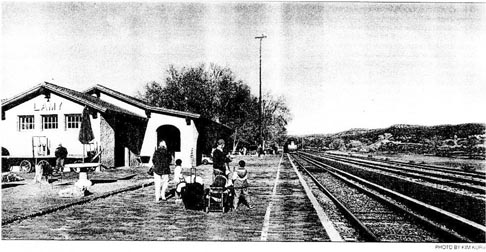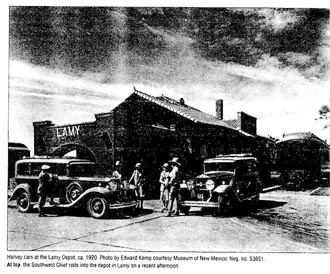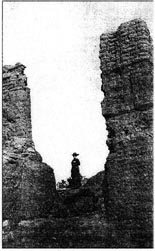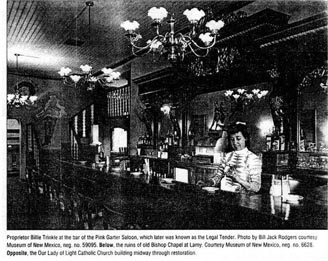



All aboard - at Lamy Station
by Paul Weideman
For 125 years the community of Lamy has been best known as the rail passenger stop for Santa Fe. Amtrtak's Southwest Chief train stops here daily on runs between Los Angeles and Chicago. The depot also serves Santa Fe Southern, which was purchased in 1992 from trhe Atchison, Topeka & Santa Fe Railway (now Burlington Northern Santa Fe) and runs tourist trains on the spur line built in 1880 from Lamy to the capital city.
Lamy - first called Galisteo Junction - was named for Archbishop Jean-Baptise Lamy, who arranged the donation of Church property for the town. "The railroad laid out the townshit and thelots are all long and narrow with the railroad right-of-way cutting through the middle," said santa Fe County senior planner Judy McGowan. Evidence of this area's long history of use can be found in Native American artifacts throughout Lamy, but there is a concentration on a 90-acre parcel located near the intersection of U.S. 285 and County Road 33 that was recently purchased throgh the county's open space program. "It's a major archaeological site," McGowan said. "There are a whole bunch of pueblos there." Paul Olafson with the county's Open Space and Trails Division said future work on a management plan for what is known as the Lamy Junction site will involve members of the community and the Archaeological Conservancy.
Santa Fe County maintains a community park on a 50-acre parcel donated by Eldorado developer AMREP, which originally thought it was the perfect site for an industrial complex. Olafson said a rire station likely would be built there or across S.F. 33 from the park, but no more intensive development is planned.
Lamy, by virtue of its rail stop, has been witness to a passing parade of people, especially in the busy early and mid decades of the 20th century. On Nov. 5, 1901, a train carried 14 Pueblo Indians, bound for Laguna, who had been at the Pan-American exposition in Buffalo, N.Y., for the past six months. "One of them said that Buffalo is a fine town but there are too many people for perfect comfort," said an item in The Santa Fe New Mexican. On March 8, 1903, John D.Rockerfeller, the richest man in America, passed through town on his way to the pacific coast. A half-century later, on Sept. 15, 1952, the newspaper carried this brief: "Four Canadians, on their way home from a stay in California, had a delay en route in Santa Fe Sunday. They were bounced off a train in Lamy by the conductor at 3 a.m. Sunday for disorderly conduct. Brought to Santa Fe by the state police, all were fined $5 each by Justice of the Peace E.C. Cortes, who evidently conducts business at the doggonesdest hours."
A quarry on the Cerro Colorado at Lamy provided the archbishop with stone for the St. Francis Cathedral, which was under construction in Santa Fe from 1869 to the 1880's. He reportedly preferred the color of the Lamy material to the pink granite and green schist commonly found in the Sangre de Cristo Mountains.
Not only did the Lamy area provide stone for the cathedral and other Santa Fe buildings, it also was the site of a busy kiln in which limestone was fired to produce quicklime for mortar. In August 2003 Ed Crocker, Crocker Ltd.Architectural Conservation, wrote "in these pages about the efforts of Abe Shaffer to excavate and restore the Lamy limekiln, including its first firing in 120 years. "The kiln he restored was the starting placed for the mortars that bind the ashlars and quoins of the St. Francis Cathedral; provided the fine, plastic material that is the plaster in the Loretto Chapel; and that was used to form the moldings and archivolts in both buildings." Crocker wrote,"It was used in many of the extant historic buildings on the Plaza and in many more that are long gone."
Lamy residents have routinely encountered vestiges of the cultural record of the place. Leslie Pierpont reports that locals turn up Native Ameican potsherds and projectile points while gardening. Members of her family have found pieces of a pipestone pipe on their property out on Los Hornos Road, which parallels the Galisteo Creek and the railroad tracks northeast of central Lamy.
Items dating to the Civil War turn up as well. "After the battle in Glorieta the Southern Confederate troops were here," said resident Karen Terry. "I found a bronze cannonball and a loader stick on my property."
Some finds from the geological record predate all human occupation. Fossils of coral and seashells testify to the fact that this area once was a sea. More than 30 years ago the Journal of Paleontology published an article titled "Statigraphy, paleontology, and paleoenvironment of a Cretaceous coral thicket, Lamy, New Mexico."
"The 'coral thicket' is a small group of colonial corals that grew in close proximity on the shallow marine Late Cretaceous (ca. 90 million years ago) seafloor that existed in the Santa Fe area," said Barry Kues, a professor in the Department of Earth and Planetary Sciences at the University of New Mexico. "Corals of any kind are rare in rocks of this age in western North America and I believe this was the first such coral occurrence documented from New Mexico. The seafloor was very muddy and not amenable to coral growth, although other types of sealife (clams, oysters, snails, ammonites) lived successfully in this environment and their fossils are abundant at some localities."
Excavating the earth in Lamy holds a promise of riches, according to local legend. "I think a stage line came through here and there's a story that a train was coming through carrying a gold bell," Pierpont said. "It was attacked by Indians so they burried the bell somewhere around here and now whenever someone's going to dig they wonder if they'll find the bell."
Terry, a local builder, believes the area was used as a cattle ranch, "maybe even before the Our Lady of Light confraternity got it," she said. "It's been called a ranch and a convent and a retreat but the old chapel out here, which was three stories high, is just ruins now. I have a copy of an article written by one of the nuns who came from back East. She mentions that when they arrived, Lamy was here to greet them."
"There was a Chinese railroad town called Manzanares upstream of Lamy. It's on an 1881 Army Corps of Engineers map, and there was a roundhouse there. There are also ruins of a pueblo that had 250 ground-level rooms, up past Leslie's, that was an outlier of San Cristobal Pueblo."
Both women mentioned a series of charcoal hornos along an arroyo up the canyon. People at one time apparently gathered pinon wood and burned it into charcoal in the earth ovens for sale to the railroad or perhaps for sale in Santa Fe or more remote markets via the railroad.
Notices in old issues of The New Mexican refer to an Onderdonk goat ranch that was in business in Lamy at least as early as 1898. A notice in the May 22, 1902, edition related that 200 kids had died at the Onderdonk farm the previous Monday night due to the extreme cold.
Lamy's 2000 population, according to the U.S. census, was 137, although during the height of the railroading era the population was perhaps 10 times that, and many of the residents worked for the Atchison, Topeka and Santa Fe Railway.
In an interview a few years ago longtime resident Carmen McGuinnis said both her father and her husband worked for the railroad. McGuinnis retired in December 2000 after 35 years as Lany's postmistress - a porch at the McGuinnis house served as the connunity's post office and as a popular gathering place for residents.
As elsewhere in the United States, the significance of the railroad diminished during the second half of the 20th century with the rise of the automobile and the automation of trains. Lamy still has its California Mission Revival-style depot, built in 1909, but a luxury Harvey House hotel named El Ortiz was torn down when rail-passenger service declined after World War II.
The local Catholic church lost parishioners as Lamy's residents moved to Santa Fe or Albuquerque for work. Ultimately the congregation was too small to warrant a priest's trip to say Mass. By the late 1980's Our Lady of Light was deemed structurally unsafe and it was closed by Archbishop Michael Sheehan in 1994. At the end of that decade Cornerstones Community Partnerships was working with volunteers to renovate the 75-year old adobe building. Work involved roof repairs made more difficult because of the existence of an attractive ceiling of antique, stamped-tin panels; restoration of the stained-glass windows; electrical wiring upgrades; and plaster repairs.
At the time Cornerstones' Mac Watson said Lamy residents built the foundation for Our Lady of Light using rubble from Cerro Colorado after quarrying operations for Santa Fe's cathedral. Another church at or near this location likely preceded the exant building; a stone there bears the engraved legend, "Nuestra Senora de la Luz, 1900." In a 2000 interview Pierpont said the father of resisent John Sanchez remembered a flood wiping out the older church building when he was three years old.
Pierpont is treasurer of Our Lady of Light Historic Foundation, which owns the church building. "We've rebuilt about half of the windows now but there's some outside work that needs to be done before they're put back," she said. "We have a good board and we're trying to raise money. It will probably take $250,000 to $350,000 to complete the project. Ed Crocker is going to help us with the church. There's a big concrete lintel at the entrance that's resting on adobe and he's going to take care of that."
She said that work, which was scheduled to begin Nov. 21, would deplete the association's funds until more is raised.
Pierpont and her husband, Johnathan, moved to New Mexico from Vermont 28 years ago. They were in Santa Fe for 10 years before they found their five-acre plot a little more than a mile out on Los Hornos Road. "There are another few homes past ours before the Galisteo Creek canyon gets too narrow," she said.
The Pierponts, like others in the vicinity, are off the grid. They have their own water well and rely on photovoltaic panels and propane to run lights and appliances. The Pierponts and many of their neighbors built their own homes. "There's a real tradition of owner-built homes in Lamy. We love it out here. It's quieter, and darker at night," she said.
The local grade school is another of Lamy's former institutions that closed as the population thinned out. "One fellow I know here went to the school until it closed, I think around 1960, and after that the kids went to Edgewood," she said. In April 2004 the Bioneers organization purchased the old Lamy schoolhouse on Cerro Circle for use as its headquaters.
Residents used to have a spring kite festival until Joe Miller bought the land they were using, Pierpont said. "After that the Rails to Trails folks proposed that we do something at their event. That's the Lamy Fair, and we've been able to raise some money for the church project with the fair."
The Legal Tender restaurant (which was formerly know as the Pink Garter Saloon) closed in 1998."There are perennial rumors that it will reopen," Pierpont said. "We miss the post office, too. It was a gathering place for people, and that's what we're hoping to church will be when it's all done."
Meanwhile residents are looking forward to the opening of Michael Gintert's new cafe in a restored rail car next to the depot. The vintage Atlantic Coast Line "Talladega," as silver, 1950 Pullman diner, is a beautiful old car outfitted with a kitchen and an 12-table dining area designed with art deco and modernistic elements.
What does Talledega refer to? "Talladega is a town in Alabama and the railroad named cars for places like that along its route, Gintert said as he showed off the fixtures in the dining car. "Sam and Allen and I knew this car was one of 10 types but we didn't know if it was the Talladega until I found some tags and then finally found the word written behind a trim panel."
Sam Latkin discovered the car in Hudson, Colo., where it had been sitting idle for two decades. (Gintert also is working with Latkin and Allen Anderson on a Lamy Railroad and History Museum.) "It would have cost us tens of thousands of dollars to get the wheels and brakes approved to run on the rails, so we had a Denver house-mover bring it here," Gintert said. "That was in February 2004. We laid 85 feet of track here to accommodate this car. The 'trucks' (the sets of railwheels at each end of the car) were taken off in Colorado and put back on here."
Gintert spent a year and a half cleaning the Talladega, and has tied hot-water lines from the Lamy Depot into the car's old steam lines for heat. The kitchen section has a coal-burnking stove he will convert to propane.
Gentert said it's too bad there's nothing at Lamy for the people who come to the station to wait for friends and family members arriving on the train, and it's even worse that travelers step off the train onto New Mexico soil for the first time to find no amenities.
"We're hoping to open the Lamy Station Cafe in January but it depends on getting power, and approval from the Environment Department," he said. "We'll start with breakfast and lunch, and parties in the evening. Even though the county didn't want me to pursue a beer-and-wine license because of the DWI problem in New Mexico, I almost have to have that if we do weddings. I'm on the church committee and it's possible there will be weddings at the church and receptions here, then people can ride the train back to town.
"Food was a big part of the railroads," Gentert said. "The trains had a great variety of food they could obtain fresh from different parts of the counntry along the route, so this is an homage to that and we'll have some menu items that recognize the tradition. Fred Harvey was noted for French toast and I love French toast so we're going to have that."
Check out the proposed menus and watch for news of the cafe's opening at http://www.lamystationcafe.com.
Santa Fe Real Estate Guide, December 2005

